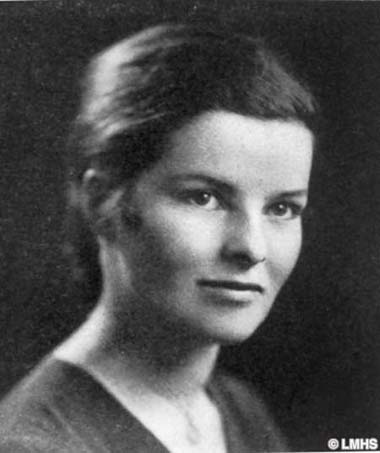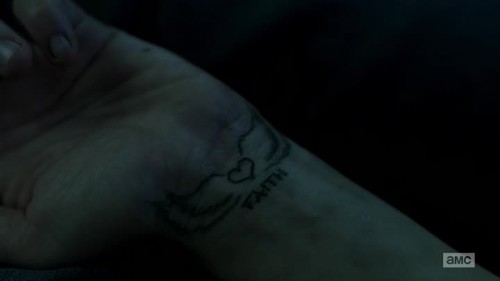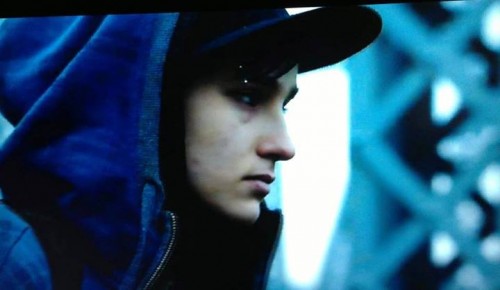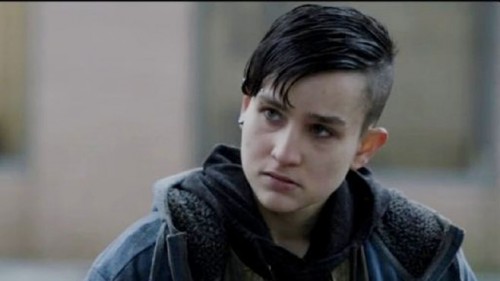This guest post by Natalia Lauren Fiore appears as part of our theme week on The Great Actresses.
When my twin sister, Jenna, and I entered Bryn Mawr College, we–like most of the 1,300 undergraduate women–were immediately drawn into the bold legacy of its most famous graduate: Katharine Hepburn, ’28. While adjusting to campus life, my sister and I would often picture the well-documented scene of Ms. Hepburn’s–Kate’s–mortifying encounter with an older girl who pointed her out as a “self-conscious beauty” the first time she walked into the college dining hall, an incident that prevented her from eating in public ever again. The isolation she experienced in her early days as a collegian wasn’t entirely self-imposed, but largely stemmed from the singular trauma of discovering her older brother, Tom, hanging from the rafters in the attic of their godmother’s house where they had been vacationing, his neck broken by a noose made of sheets which he had apparently been using as props during a play rehearsal. The event changed Kate irrevocably and, as she later recounted, split her into “two people instead of one, a boy and a girl” (Life: Remembering Katharine Hepburn 10 Years Later, p. 32, 37).

During history classes in Thomas Great Hall, Jenna and I would imagine Kate, on cold winter nights when she was tired of studying, in the outdoor Cloisters of the then-library, stripped of her clothing, skinny-dipping in the fountain–an adventurous tradition which, by her own account, seemed to take root in her father’s odd insistence that each of his children take baths in ice-filled tubs every morning before school (Jane Fonda: My Life So Far, p. 418). Kate fully embraced her father’s practice as a “character and constitution-building ritual” she continued beyond the confines of the college cloisters. It was in those cloisters that Kate’s emerging confidence as a collegian would be propelled by an insatiable determination to inhabit the stage, which she did to sensational effect on May Day 1927 when she appeared as a strange, fierce girl/boy in The Truth about Bladys, a play by A.A. Milne.

Kate’s stage debut in Bladys the year before she graduated inspired the college to select May Day for the annual ceremonial screening of The Philadelphia Story (1940), a box office hit written for Kate which would, by her own orchestration, transform her image from “box office poison” to bankable screen star. When Jenna and I gathered with the other girls in Thomas Great Hall, or outdoors on Merion Green to enjoy the ritual screenings, we would marvel at the impossibly elegant and graceful image of Kate as Tracy Lord, “the goddess lit from within,” who could only be described using John Wayne’s exclamation on the 1975 set of Rooster Coburn, “DAMN! THERE’S A WOMAN!”
While this ritual screening was initially intended to instruct the Bryn Mawr women on the virtues of marriage–something Kate herself fleetingly tried with Main Line heir Ogden Ludlow on the heels of her graduation from the college–the real lesson lies in the demonstration of Kate’s fearless initiative behind the camera. She secured the film rights and nurtured the project herself, rewriting the script with playwright Philip Barry, committing to performing it onstage, and firmly negotiating her own terms which stipulated that she play the lead onscreen as well–a miraculous feat for a woman navigating the strictly patriarchal movie-making industry at the dawn of its Golden era (Life: Remembering Katharine Hepburn 10 Years Later, p. 42, 64).

But the prevailing image of Kate that engaged us while at the college and has remained with us since is a far less overtly glamorous or legendary one that came not from her own life story, nor her onscreen presence, but through someone else’s. On freezing winter nights when we exited the dining halls with our teeth chattering from irresistible yogurt topped with Oreos, too cold to even entertain the notion of plunging nude into the cloister fountain, Jenna and I would instead snuggle against the heated bay windows of our dorm, reading memoirs and biographies together. Of course, there was Kate’s memoir, Me, and A. Scott Berg’s commemorative biography, Kate Remembered, released 12 days after her death. Yet, this prevailing image appeared in Jane Fonda’s intimate, inspirational, and moving memoir, My Life So Far, which proved revelatory for us as “self-conscious” young girls on the cusp of womanhood. In chapter 8, Fonda recalls the filming of On Golden Pond (1981) with the then 73-year-old Kate, and her father, Henry Fonda, whose health was rapidly declining during the shoot.


Fonda documents how initially Kate “disliked” her, but after filming a scene which demanded that she, in Kate’s words, “face her fears” and resist the danger of “becoming soggy,” the elder actress took on the role of Fonda’s surrogate mother despite the fact that she had never had any children of her own . During the “mothering” she received from Kate, Fonda explains how her elder co-star firmly encouraged her to be more self-conscious–not in the negative sense, but in the sense that she should develop “a consciousness of self,” an awareness of “the impact our presence has on other people”–an awareness Kate herself possessed since those early days at Bryn Mawr, and had already mastered in her portrayal of Tracy Lord opposite Cary Grant, who affirmed her power to stir people:
“…She had this thing – this air you might call it – the most totally magnetic woman I’d ever seen and have ever seen since. You HAD to look at her. You HAD to listen to her. There was no escaping her.” (Life: Remembering Katharine Hepburn 10 Years Later, p. 42)
Kate was also aware of the power Henry Fonda’s presence had on his daughter during the filming of On Golden Pond–a strained dynamic that often left Fonda feeling dismissed, discouraged, and–at its climax–depleted of the emotion she needed to perform the major scene of the film. Mortified that she had become “dry” and panicked that her father would find out, Fonda confided in Kate, who came to set even though she wasn’t expected to be there that day. As the director gave the cues to begin filming, Fonda tried to buy time, telling him that her back would be to the camera until she was ready for him to roll. Then, at “the time of reckoning,” she describes the image before her and its impact:
“I turned away to prepare, though I had no idea what to do, and as I was staring at the shore, trying to relax and bring myself into the scene, there was [Kate] Hepburn, crouching in the bushes just within my line of vision. Nobody could see her but me. She fixed me intensely with her eyes, and slowly she raised her clenched fists and shook them as if to say, “Do it! Go ahead. You can do this!” She was willing me into the scene: Katharine Hepburn to Jane Fonda; mother to daughter; older actress, who’d been there and knew about drying up, to younger actress. It was all those layers of things and more. Do it! Do it! You can! I know it. With her energy, she literally gave me the scene, gave it to me with her fists, her eyes, and her generosity, and I will never, ever forget it.” (Jane Fonda: My Life So Far, p. 436-437)
In essence, Kate took the role of Fonda’s off-camera scene partner, aware of how her presence and maternal connection to the younger actress could draw out a great performance. With her fists, she motivated Fonda to face her fears and to confront the difficult, painful emotions that had both plagued and eluded her on and off the screen.

As Fonda points out, Kate had been there, often forced to elicit emotion with no one present to draw her into the scene. For Guess Who’s Coming to Dinner (1967) 14 years earlier, she played many of her scenes to an empty wall since Spencer Tracy, only weeks from death, no longer had the stamina to sustain a full-day’s shoot (Life: Remembering Katharine Hepburn 10 Years Later, p. 35). She had famously met “Spence” on the set of Woman of the Year (1942), their first exchange characterized by Kate’s observation, “You’re not as tall as I expected,” which revealed the self-conscious awareness of height as integral to her image and presence. Despite the producer’s prediction that Spence would “cut her down to size,” Kate is a force to be reckoned with as Tess Harding, the smart, successful foreign correspondent whose talent and ambition are tested once she marries. In the film’s penultimate scene, which my sister and I would watch on repeat at Bryn Mawr, Tess breaks into her estranged husband’s apartment with the intent to win back his affections by cooking him breakfast. Kate carries much of the scene herself without dialogue at her disposal until Spence’s character, Sam, enters the kitchen where Tess is making a mess of the meal. With impeccable comedic timing, Kate captures Tess’s misguided determination to demonstrate her domesticity.

Especially in the silent moments, she commands the viewer’s attention–as she did Fonda’s, who “never tired of looking at her”–with her massively expressive eyes that, according to Cary Grant, “could see right through the nonsense in life” (Life: Remembering Katharine Hepburn 10 Years Later, p. 62), and her perfectly sculpted cheek-bones that held the intensity of her expression and that grew even more defined and magnificent with age (Jane Fonda: My Life So Far, p. 427). Defying the producer’s prediction, she instead extenuates her height through the agility of her movements and through the pant suits she insisted on wearing before they had become the acceptable fashion for well-bred women.
The legacy of Kate’s “pant suit look” for modern professional women was recently depicted in an episode of CBS’s critically-acclaimed drama series, The Good Wife when a judge asks Alicia Florrick (Juliana Margulies) what she is wearing. Alicia replies, “A pant suit, your Honor.” The judge admonishes her, “In my courtroom, Mrs. Florrick, men wear suits and women wear skirts.” One can imagine what Kate’s reaction would have been had the judge said that to her character, Amanda Bonner, in the romantic-comedy Adam’s Rib (1949)–perhaps a forerunner of The Good Wife–that again pits her against Spence, this time as married lawyers arguing opposing sides of an attempted murder case.

Most of the nine films Kate and Spence did together feature battle-of-the-sex plots which, at certain points, blurred or even reversed the roles women and men typically played in marital or committed relationships. These plots suited Kate’s life-long image of herself as inhabiting both female and male traits, particularly in the wake of her older brother’s tragic death. Six years before her pairing with Spence, she unabashedly emphasized her androgynous traits, shaving her head to play a boy for Sylvia Scarlett, just as 19-year-old actress Bex Taylor-Klaus recently did for her role as the lesbian tomboy, Bullet, in the third season of AMC’s crime drama, The Killing. The legacy of Kate’s powerful presence is recognized in Bex’s “self-conscious” performance, which takes root in her eyes and manifests itself in the nuances of her expression, movement, and stature. It is also recognized in the onscreen power of other contemporary actresses, notably Cate Blanchett, who won a Best Supporting Actress Academy Award for her portrayal of Kate in Martin Scorsese’s film The Aviator (2004), chronicling the life of Howard Hughes.

And there’s Jane Fonda herself, who seems to have permanently absorbed the physical and emotional energy Kate gave her that day when she was “dry.” This past year, Fonda appeared as ruthless reporter Leona Lansing in HBO’s The Newsroom. Her performance is magnificent, particularly in the final scene of Season 2, Episode 7 when Leona refuses to accept her staff’s resignation after a scandal. Like Kate, she commands our attention, utilizing every ounce of her presence and engaging our emotions with her vivacity and humor. Fittingly, her role is that of motivator–the encourager behind the scenes willing her dishonored staff to “Get it back!”
[youtube_sc url=”http://www.youtube.com/watch?v=7i4zNm4KqYg”]
When she was working with Kate for On Golden Pond, Fonda details her elder co-star’s stubborn conviction–despite her liberalism and feminist persona as the daughter of a suffragette who was also a Bryn Mawr alum (Class of 1899)–that a woman could not balance an acting career with motherhood if she wanted to be “great.” As director Frank Capra attested:
“There are women – and then there is Kate. There are actresses – then there is Hepburn. She is wedded to her vocation as a nun is to hers and as competitive in acting as Sonja Henie was in skating.” (Life: Remembering Katharine Hepburn 10 Years Later, p. 69)
Kate’s unwavering dedication to this “vocation” produced an unprecedented career that lasted decades and won her a record four Academy Awards, the last one for On Golden Pond. Fonda recalls that the morning after her win, Kate telephoned to gloat, “You’ll never catch me now!” (Jane Fonda: My Life So Far, p. 439). Indeed, Kate’s record remains intact, although the indefatigable Meryl Streep is close, having won three and mostly likely poised to win another in the near future. But perhaps one could interpret Kate’s boastful exclamation as more of a motivating challenge–a “raising of the fists,” across the ages–willing younger generations of actresses to face their fears and to be conscious of their presence.
In 2006, three years after Kate’s death at age 96, Bryn Mawr established the Katharine Houghton Hepburn Center, which hosts the Hepburn Medal ceremony, a lifetime achievement award given to women artists and activists who have transformed their worlds. Recalling Jane Fonda’s memoir, my sister and I imagine that if Kate were alive, she’d pointedly challenge the younger actress in her maternal “God-is-a-New-Englander” voice, “Well, if you can’t catch me in the Oscar count, you can win a Hepburn Medal instead!”

Natalia Lauren Fiore received a B.A. in Honors English and Creative Writing from Bryn Mawr College and an M.F.A in Creative and Professional Writing from Western Connecticut State University, where she wrote a feature-length screenplay entitled Sonata under the direction of novelist and screenwriter, Don J. Snyder, and playwright, Jack Dennis. Currently, she holds a full-time tenure track teaching post at Hillsborough Community College in Tampa, Florida, where she teaches English and Writing. Her writing interests include film criticism, screenwriting, literary journalism, fiction, the novel, and memoir. Her literature interests include the English novel, American Literature, and Drama – particularly Shakespeare. She blogs at Outside Windows and tweets @NataliaLaurenFi.







